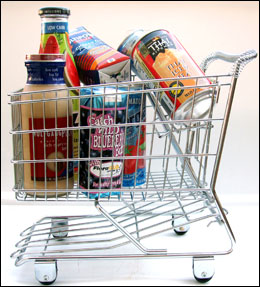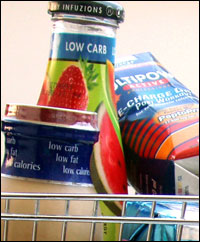
Bars, as in nutrition, meal replacement, energy, etc., have seen their high. By no means are these "power" bars going away, but it appears as if their novelty has worn off with everyday consumers. Bars have found their niche and have paved the way for innovations in beverages, as consumers are now familiar with nutrient-dense, on-the-go foods.
At the recent IFT Annual Meeting + Food Expo® in New Orleans, ingredient suppliers showed that they clearly believe beverages to be the future of the functional foods trend. And, excitingly for the dairy industry, most suppliers will agree that dairy in the ingredient mix is the key to flavor, mouthfeel, nutrition profile and overall consumer acceptance.
Some examples sampled at IFT include probiotic smoothies and lutein-fortified juice milk blends. Whey and select milk peptides also were showcased in low-calorie, low-sugar tropical flavored drinks. With the Expo in The Big Easy, some suppliers went so far as to formulate non-alcoholic hurricanes packed full of dairy proteins and dairy-sourced calcium.

Back to IFT, one supplier demonstrated its ability to help food and beverage companies develop products that resonate with specific consumer segments. One of the segments identified as an opportunity is "tweens," which are children between the ages of eight and 12 years old. Why tweens? Because tweens become teens, and today's teens are becoming more and more conscious of the food and beverage choices available to them.
In addition, another key consumer segment is moms, as when it comes to moms buying beverages for teens, tweens or anybody in the family, they have some real priorities.
Dairy Foods worked with Parenting Magazine's online MomConnection.com panel to find out what attributes are most important in beverage selection. In a survey conducted in May 2005, 66% of the 997 moms who responded said taste is extremely important when deciding what beverages to purchase for their family. And though cost was important (23%), being a good source of nutrition ranked second with 34% of respondents saying this attribute was extremely important. (See Table 1.)
When moms were asked what they would tell beverage manufacturers to do to better meet their needs, moms had a lot to say. Here are some verbatim quotes.
- "Stop making the stuff that is so bad for kids appealing to them."
- "Healthy drinks for my family are important to me. Low- or no-sugar without sacrificing taste."
- "Make the healthier beverages less expensive."
- "I would like to see regular milk come in neat bottles that make kids want to choose that over bug juice. Also, the chocolate milk is far too sweet. There should be a light, low-sugar chocolate milk, again in a fun package."
- "More drinks with whey or soy protein added that are not gritty and nasty."
- "I would like to see more beverages offered in child-size servings."
- "More good-tasting, nutritious beverages at a reasonable cost."
- "I would like all drinks to come equipped with straws and be resealable."
- "Not so much sugar, and don't replace it with artificial sweeteners."
- "Invent healthy drinks for kids that are portable and taste great (loaded with vitamins and nutrients)."
- "It's 2005. I find it hard to believe that beverage manufactures cannot come up with drinks that are nutritious and that taste nice. However, I resent how they offer new drinks at such outrageous prices. Let's be reasonable!"
- "First of all, why is it that soda is so much cheaper than juice or milk? It's no wonder the world is so unhealthy, if we try to be healthier we'll go broke."

According to BuzzBack Market Research's Annual 2005 Teen Health & Nutrition Survey, U.S. teens have already come to appreciate the health/wellness benefits of food and beverages. The online survey of 532 U.S. teens shows that, "Although primarily concerned about how they look and feel now, many teens also think about the future and how their current diet could impact their health later in life," says Carol Fitzgerald, founder and president of BuzzBack LLC, New York. "Products that can help alleviate these concerns are appealing."
Teens today are very aware of the wide array of food choices available to them. "They believe that diet can have a direct impact on their health, well-being, energy levels and performance in sports, weight and appearance," says Fitzgerald. "They prefer to eat foods that are good for you but don't want to sacrifice taste. They also are constantly on the move and want foods that are quick to prepare and can be eaten on the go."
More than half of the teens surveyed say they have changed their diet over the past year and are eating healthier foods, and more than half express a desire to eat better in the future. When asked how their eating habits have changed, the most common answers (each specifically mentioned by more than 10% of respondents) centered on drinking more bottled water and eating more fruits and vegetables and other "healthy foods."
A 16-year-old Caucasian female said, "I drink healthier by trying to replace soda with water or juice." A 15-year-old Hispanic male commented, "Coffee, protein shakes, bottled water. All these drinks keep me in shape."
This study affirms that teens are receptive to change and love trying new products. Of the teens surveyed, more than two-thirds have tried a new snack, food or beverage within the past year, and among younger teens, the percentage was even higher (75%).
"For teens, two of the most important attributes for new products are 'fresh' and 'convenient,'" says Fitzgerald. "Teens also tend to find foods with added benefits (e.g., extra vitamins) more appealing than foods with reduced levels of ingredients (e.g., reduced salt, reduced carbs)." (See Table 2. and Table 2 \[continued\])
Just as males and females have food and beverage preferences later in life, the BuzzBack survey indicates that these differences start in the teen years. For example, male teens are less interested in weight control and more interested in foods' performance and strength-enhancing properties. Male teens find foods with added protein more appealing than female teens. Similarly, males drink more milk, sports drinks, energy sodas and other energy drinks than females.
The study also indicates that all teens consume three snacks a day, as compared to eating an average of 2.4 meals daily. When asked to select one's top-three favorite snacks of the choices provided, chips came in first place. Other popular snacks included cookies and ice cream. Interestingly, 17% of teens picked yogurt as a favorite snack, and 10% picked smoothies. Only 6% of the teens surveyed cite energy/meal replacement bars as something they eat frequently as a snack. "These bars were mentioned frequently in responses to open-end questions suggesting that there is a lot of interest in them but that the product offerings currently available often fall short of expectations," says Fitzgerald. (See Table 3.) This is a real opportunity for dairy processors to deliver a comparable energy/meal replacement beverage.
When it comes specifically to beverages, the survey indicates that teens drink more bottled water than any other beverage. "Fruit juice, tap water and milk are popular as well, exceeding carbonated soft drinks and other sweeter beverages as typical of what teens are drinking," Fitzgerald says. (Hallelujah!) "Of the newer beverages, sports drinks and energy sodas are the most popular." Several differences exist between male and female teens. Males drink more milk, sports drinks, energy sodas and other energy drinks while females, who tend to be more weight and health-conscious, drink significantly more bottled water, diet soda and smoothies. (See Table 4. and Table 4 \[continued\])
The findings from this study suggest some new product opportunities. For example, there may be an opportunity for more to-go breakfast foods, as breakfast is the meal that is most often skipped or eaten on the run. With respect to beverages, the demand for healthier choices among teens is large and growing. Teens are also interested in healthier snacks, but do not want to sacrifice taste.
Several themes emerged from the BuzzBack survey regarding innovation opportunities in beverages. These include more, better and fresher smoothies, sports drinks with better performance enhancers and that hydrate for a longer time, and better-tasting, healthy meal replacement drinks.
A 16-years-old African-American female said she would like a smoothie where "you could get all the nutrients you need, that tastes good, helps you stay in shape and is good for you. Packaging would be bright."
|
Want more ideas on how to market to moms? You should, as research shows that 60% of moms feel that marketers are ignoring their needs. Here's your chance to learn from nationally and internationally recognized marketing-to-moms leaders from research companies, media and agencies, and category leading brands worldwide. After all, moms buy for their children . . . they buy for the home . . . they also buy for themselves. Get your share and keep your brand top-of-mind in a market driven by time, place, need and urgency. Check out www.m2moms.com to learn how to increase your share of moms' purchasing. BuzzBack LLC conducts online market research, providing innovative solutions to companies in the consumer packaged goods industries, as well as other. BuzzBack delivers Blended Research™ - rich consumer insight that blends quantitative (the "what") and qualitative (the "why") data and analyses - allowing for deeper understanding of consumer attitudes and purchasing behavior. For more information visit www.buzzback.com. Want more ideas on how to leverage dairy in the beverage business? Look to the August issue of Dairy Foods for the DMI-sponsored supplement Tools for Innovation. |